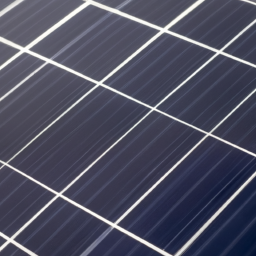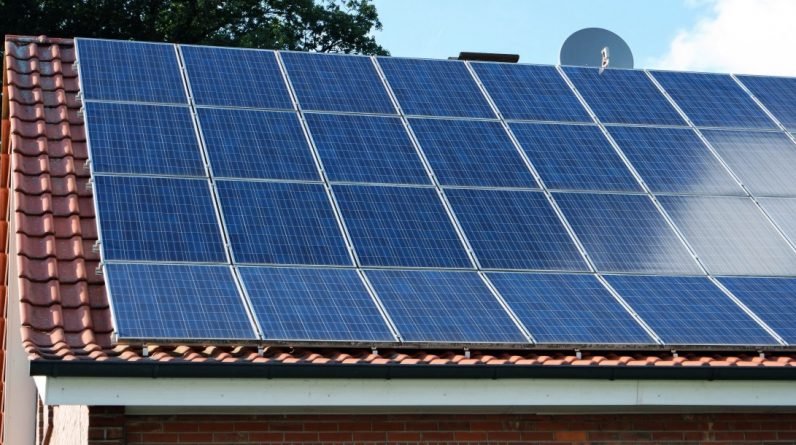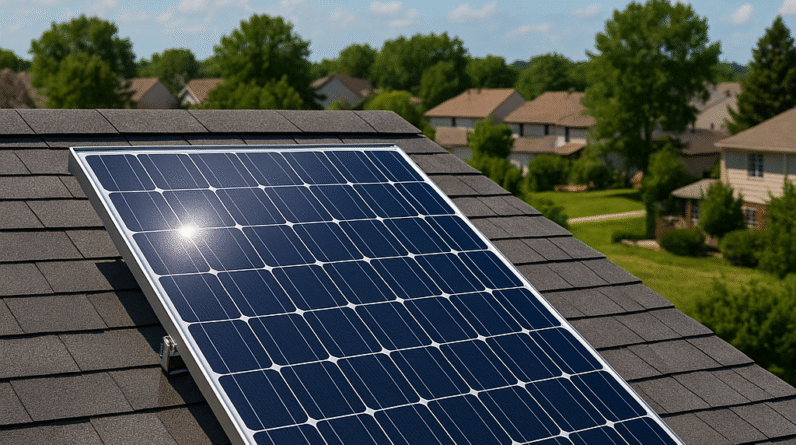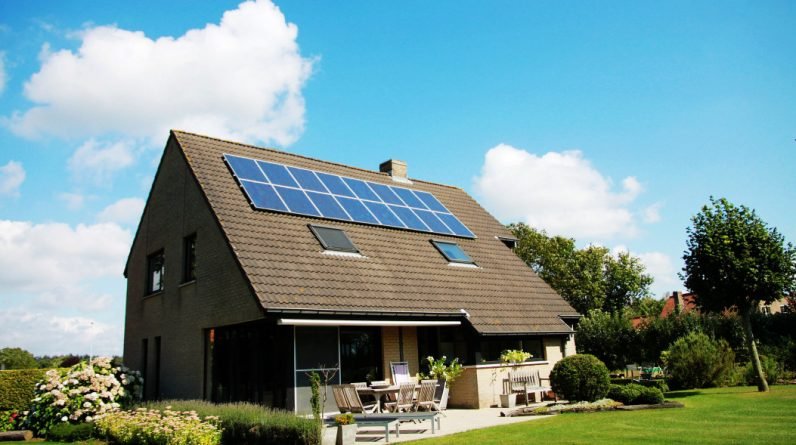
Learn How Solar Power Works
Learn How Solar Power Works. The rays of sun generate radiant energy. Using different types of machines, this radiant energy can be captured, stored and treated to form other types of usable energy, as our needs might be. Solar power refers to the procedure of generating mechanical power, electricity or chemical power from solar energy resources. Solar chimney, solar heater, photovoltaic (PV) cells and solar roof tiles are some of the devices that can treat and harness solar energy. Among these devices, solar power roof tile has various advantages, and hence is generally preferred over other forms of commonly seen roof tiles. Roof tiles that are designed so that they can tap and process solar energy to produce electrical power or heat up water are called solar roof tiles. An industrial designer from Australia is credited with the invention of these solar roof tiles.
Learn how solar power works and uncover how this revolutionary energy source is reshaping our planet—and your wallet. Are you tired of rising electricity bills and the constant guilt of your carbon footprint? You’re not alone. Millions are searching for cleaner, smarter alternatives to fossil fuels, but confusion and misinformation often cloud the path. Let’s clear the haze.
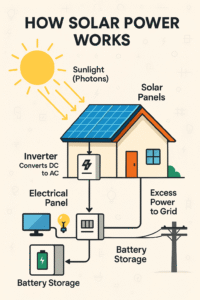
How Solar Power Works: Breaking It Down Simply
At its core, solar power works by converting sunlight into electricity using photovoltaic (PV) cells. These cells are typically found in solar panels installed on rooftops, ground mounts, or solar farms. When sunlight hits these cells, it excites electrons, producing direct current (DC) electricity. This DC power then passes through an inverter, transforming it into alternating current (AC)—the kind used by homes and businesses.
The Photovoltaic Effect: Turning Sunlight Into Energy
The magic behind solar panels is the photovoltaic effect, a process where semiconductors (usually silicon) absorb photons from sunlight. This releases electrons, creating an electric current. Here’s how it happens:
- Sunlight hits the solar panel.
- Electrons are knocked loose from atoms in the semiconductor material.
- Electric fields direct these electrons into a flow, generating electricity.
The Role of Inverters, Batteries, and Grids
How Inverters Work in Solar Systems
Inverters are the unsung heroes of solar energy systems. They:
- Convert DC electricity to AC electricity.
- Optimize power output using technologies like MPPT (Maximum Power Point Tracking).
- Enable grid communication for net metering and monitoring.
Energy Storage with Solar Batteries
For homeowners aiming for energy independence, solar batteries store excess energy for nighttime or cloudy days. Lithium-ion batteries, like the Tesla Powerwall, are popular for their efficiency and longevity.
Tied to the Grid or Off-Grid?
- Grid-tied systems send surplus power to the utility grid, often earning credits via net metering.
- Off-grid systems rely entirely on solar panels and batteries, ideal for remote areas.
Benefits of Using Solar Power at Home
Switching to solar offers a range of benefits:
- Lower Energy Bills: Generate your own power and reduce reliance on utilities.
- Eco-Friendly: Slash your carbon footprint with zero-emission energy.
- Increased Property Value: Solar-equipped homes often sell for more.
- Incentives and Tax Credits: Federal, state, and local programs help offset installation costs.
Common Questions About Solar Power Answered
Is Solar Power Effective in Cloudy or Cold Climates?
Yes. Solar panels still generate electricity in overcast weather and even snowy conditions—just at slightly reduced efficiency.
How Long Do Solar Panels Last?
Most systems last 25–30 years with minimal maintenance. Performance may degrade slightly over time but remains efficient.
What’s the Installation Process Like?
A professional will assess your roof, design a custom system, obtain permits, and install the panels—typically in a few weeks.
Future of Solar Energy: Innovations on the Horizon
The solar industry is evolving rapidly. Expect to see:
- Higher-efficiency panels using perovskite materials.
- Integrated solar roofing (like Tesla’s Solar Roof).
- Smart grid integration for optimized energy use.
- Affordable solar for low-income households via new funding programs.
Conclusion: Start Harnessing the Sun’s Power Today
Understanding how solar power works is your first step toward energy freedom, financial savings, and environmental stewardship. The technology is here, the benefits are clear, and the future is bright. Don’t wait—explore solar options for your home today.
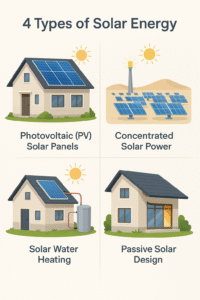
Would you like to generate SEO-friendly titles and descriptions?
Getting to know the functionality of solar power roof tile
The modern day city is facing a serious problem – an acute power shortage. Solar power roof tile comprises of such techniques can solve this problem. Polycarbonate chassis is used to make up the solar power roof tiles, and it also contains a vessel of water and quite a number of photovoltaic cells (i.e. solar power cells). These solar cells are able to capture around 72%-80% of the total available sunlight. This is then transformed into heat energy, which in turn, warms up the water in the vessel. The electric wires of the building as well as the hot water system need to be connected to these tiles. The domestic requirements of electricity can be easily met by harnessing the sunlight that remains (around 20% of the total).
A handy boost to power savings is also achieved, since the roof tiles generate electricity that are well in excess of what is actually required in a home. Not much power is required from non-solar origins, since the excess electric power that is generated during the day can be easily utilized at night. Adding to the convenience is the significant backup they provide on days when the sky remains covered with clouds. Let us now look at how the system works. An inverter is kept present, to which the photovoltaic cells are connected. This setup is then attached to the main power box of the house. An electricity grid is also used, and the power box is kept linked to this grid. Now, this electrical grid can store all available surplus electricity. This excess electrical power can even be sold to the grid and some money can be earned. This helps the user gradually get back part of their investment on the solar roof tiles. After some time, the effective cost for producing electricity can even become zero too! Hence, installing the tiles makes sense, since they not only help a home generate its own electricity, but also prescribes a way to earn by selling off excess amounts of power.
All forms of different roof tiles can be easily matched to the solar power roof tiles, such are the designs of the latter. An estimated amount of 1.5 kilowatts of electrical power can be obtained if 200 solar power roof tiles are used. This electricity is enough for the needs of a home that has three to four bedrooms. In the current world, these tiles are in great demand, both for commercial as well as residential purposes. The commercial tiles can be installed easily and quickly, by following a simple procedure. They do not enter the building structure as such, and also have high wind resistance properties. Research show that these solar roofs can resist winds blowing at up to 120 miles per hour too. These solar power roof tiles can also be fitted in rather short spaces that might be available. Thus, wastage of excess power can be stopped, and the required amount of electricity can be produced by having the roof tiles at all places of the house that gets exposure. Other aspects of the solar tiles, like their cost figures, their efficiency and other likely side effects need to be paid due attention as well.
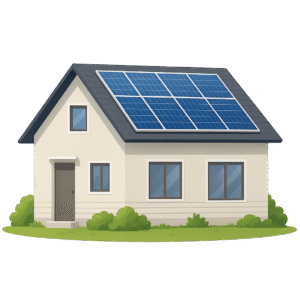
Gauging the utility of solar power roof tile
The solar power roof tiles have such structures that they can be easily matched with most types of different concrete tiles. Hence, the resultant streamlined appearance of the roof enhances the overall fashion and décor of any building. Solar roof tiles generally need to be installed only once during one’s lifespan. After installation is complete, there are absolutely no operating costs of these solar tiles, and they are expected to last around a period of thirty years. Many of the companies also offer production warranties for a 25 year period in addition.
Adding significantly to the process of installation of the solar roof tiles is the fact that, these tiles do not have other portable components that have to be moved as well. Solar power roof tile is extremely eco-friendly as well, since they do not pollute the atmosphere in any way, and do not emit any harmful greenhouse gas. Once solar roof tiles are in place, users can save extra amounts of power that is generated, produce electricity using a free and renewable source of energy, and make the appearance of their houses visually pleasing as well. Economic benefits from these solar power tiles are also significant.
You should be installing solar power roof tile if you wish to cut down on your power bills. Home solar systems are also ideal for generating electricity in an environment-friendly way. What you should do first is to get a guide that would help you know the basic stages of installing the system, and the places that are best suited for it. Relevant security measures, as well as how the wiring should be done is also discussed in such a guide. You can also learn from where to get the components of the system at rather low prices, and the batteries totally free. Once such a guide has been consulted, you are ready to set up a solar power system at your home.


